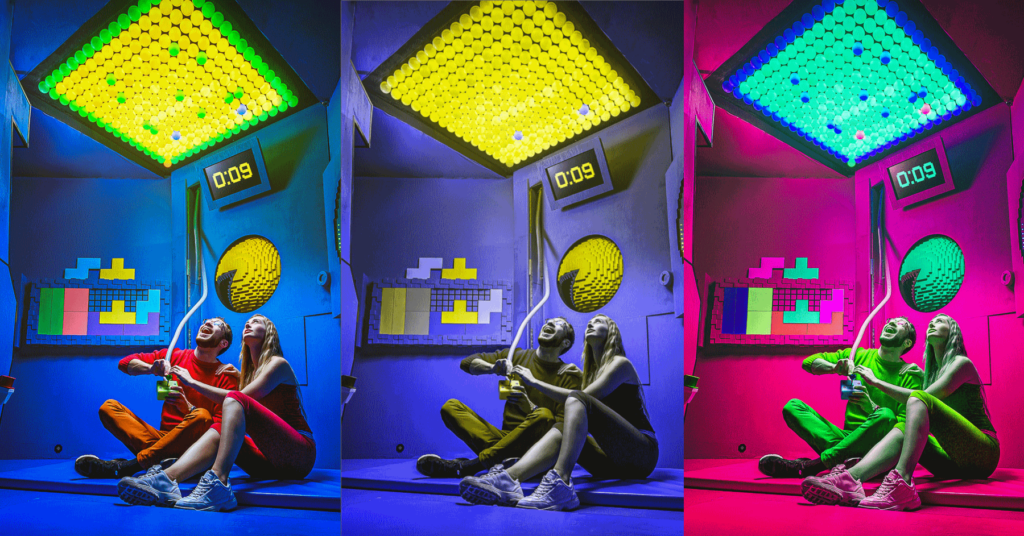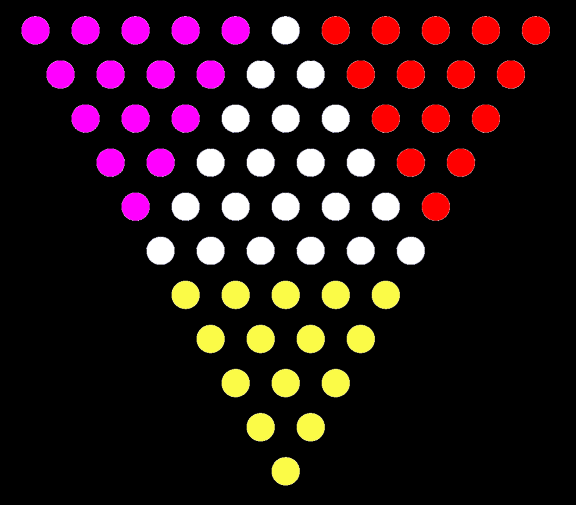Just had a call with the owner of an escape room. I chatted with the game master after a game, which saw my wife and I go head-to-head in an arcade style battle. The theme was highly colorful and being alone in the room without my wife to rely on posed several issues.
SNAKE
First, there was a game of Snake that you play on the ceiling. Once my snake reached 3-4 pixels in length, the game would restart. I assumed the game was glitched until I started talking to my wife across the wall. Nope! It turns out there were ‘hidden’ green blocks on the yellow background that I kept running into and dying. Hidden to me at least. Without knowing where they were, I could just hope to avoid them, but eventually just put down the joystick and waited for my wife to trigger the next stage.
My Solution? Change the colors. The hardware for this game relies on RGB LEDs, which means the code just needs one number to change to make that green darker, and therefore differentiable from the yellow background.

Left: the original – red-green colorblind people do not see the green blocks on the yellow background
Middle: simulated protanopia – color normals can see what a I see
Right: Hue-shifted – the colorblind can now see where the green blocks are.
TRIFORCE
Second, there was a triangle of colored LEDs that you need to use some buttons to rotate and slowly arrange into a triforce pattern. This pattern must match a picture on a screen elsewhere in the room. The first problem, is that the colors (blue and purple) looked very similar and were barely differentiable, but I managed. However, knowing which corner each color was supposed to go in was a wild guess, since the colors on the puzzle and the color on the solution reference in the other part of the room were not directly comparable.
My Solution? Again… change the colors. Getting four colors that are not only easily differentiable, but also can be compared to a solution with slightly different colors is quite easy to satisfy all dichromats: purple. red, yellow, white. I also recommended changing the logic of the puzzle so that it doesn’t matter which colors are grouped in which corner, as long as they ARE arranged in that ‘triforce’ pattern. I imagine a color-normal person would never ‘chance’ into an alternative solution and it should only matter to not frustrate a colorblind player when they think they’ve found the solution, but got the colors from the reference mixed up.

LASER
Finally, there were two puzzles with lasers. The first required a Katherine Zeta-Jones style maneuvering around the lasers (I imagine I was just as sexy). The second was a classic ‘arrange the mirrors to get the laser to hit the target’ puzzle. I had no issues with these… because I specifically chose the blue-room instead of the red room. Blue lasers are super visible to me, but red lasers are often invisible, as they are to most protans. Had I been in the red room, that would have been two more unsolvable puzzles for me.
My Solution? Well, without ruining the red vs. blue theme so carefully conserved by the owner, just ensuring that colorblind people go in the blue room is all that is necessary here. Just a little extra training for the game masters, or something to add to the disclaimer.

HIS SOLUTION
Funnily enough, the owner tells me that they have a colorblind game master that also had trouble with all of these things. Whoops.
Changing even one number in code can be expensive when you outsourced the development (this I know), which is why things like colors should be stored in a parameter file that can be easily changed by the end user. The compromise for the owner was to put a message on the booking website that colorblind people should be in at least a group of 3 so they aren’t alone in a room, and they will look into having some cheap ‘colorblind glasses’ on hand. This is actually a pretty good application for some cheap magenta lenses, since there is no Denotative Color Task involved in the rooms. While I usually refer to these lenses as a blunt instrument, a filter that can just tweak the yellow and green in the Snake game to look slightly different without caring that everything may look ‘unnatural’, is a great solution in this over-saturated escape room.
Out of 50-60 escape rooms I have done with my wife, maybe about half have had puzzles that are at least very difficult for me, if not impossible, and the vast majority of those could have easily been designed to be colorblind friendly without sacrificing the theme. Have you ever had trouble in an escape room because of your colorblindness? Tell me about it in the comments.
Leave a Reply